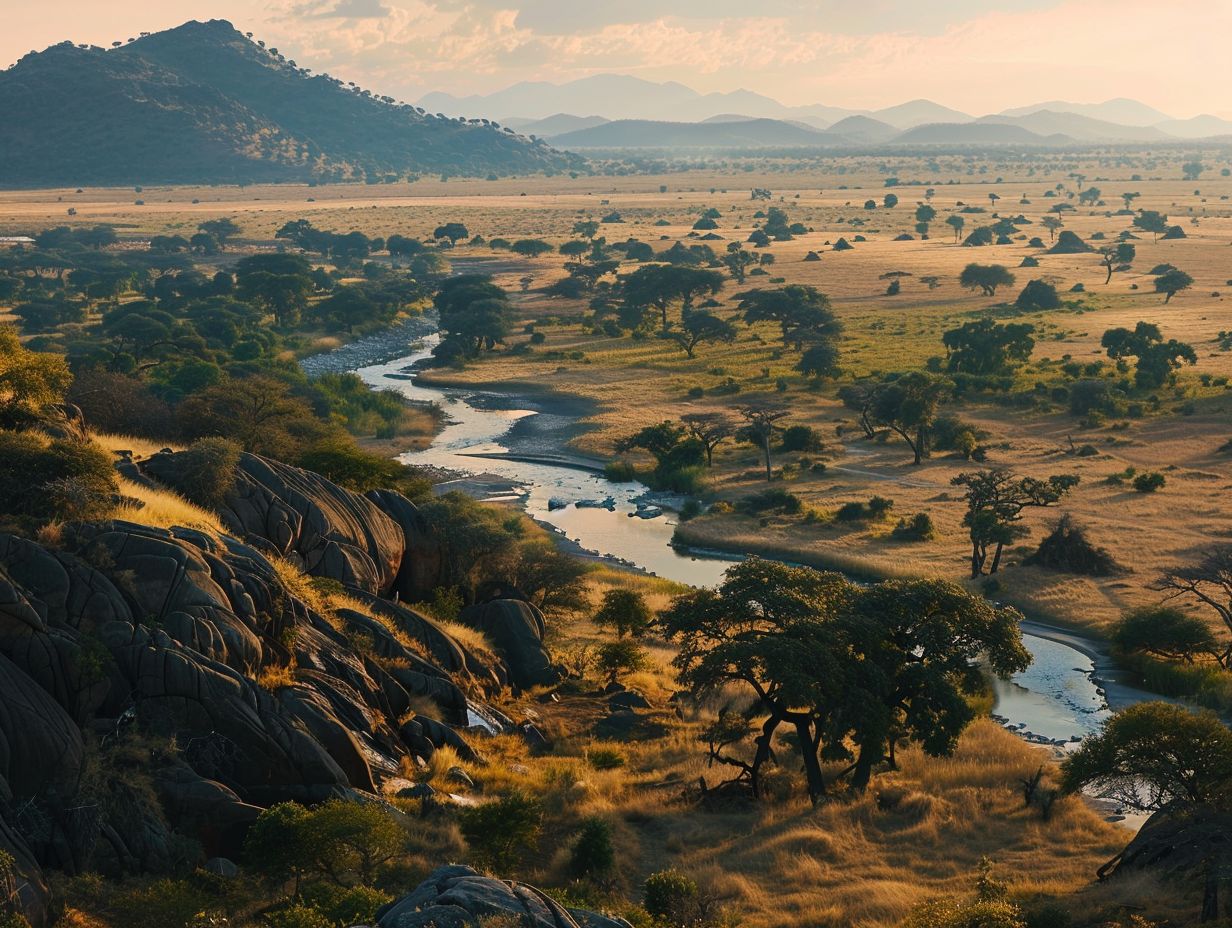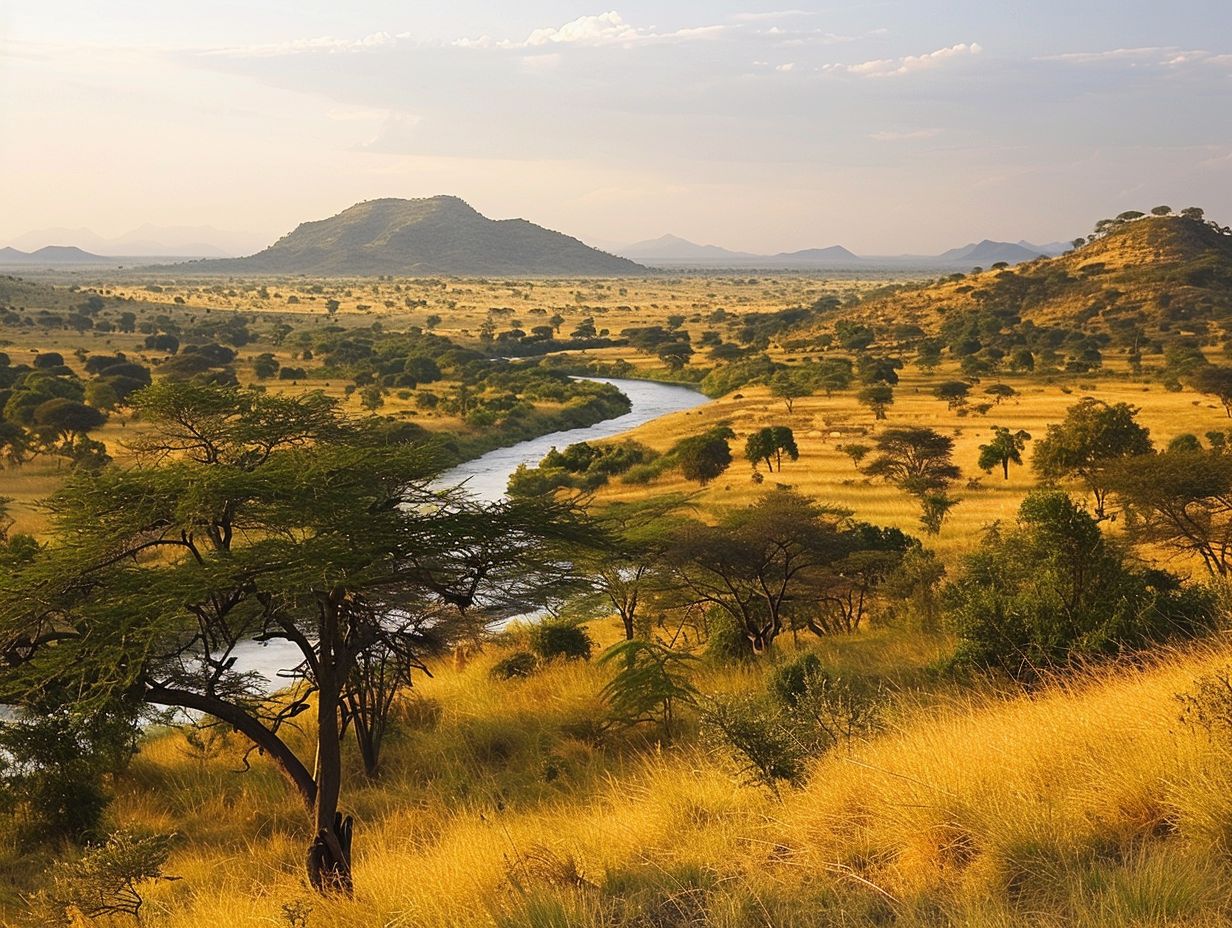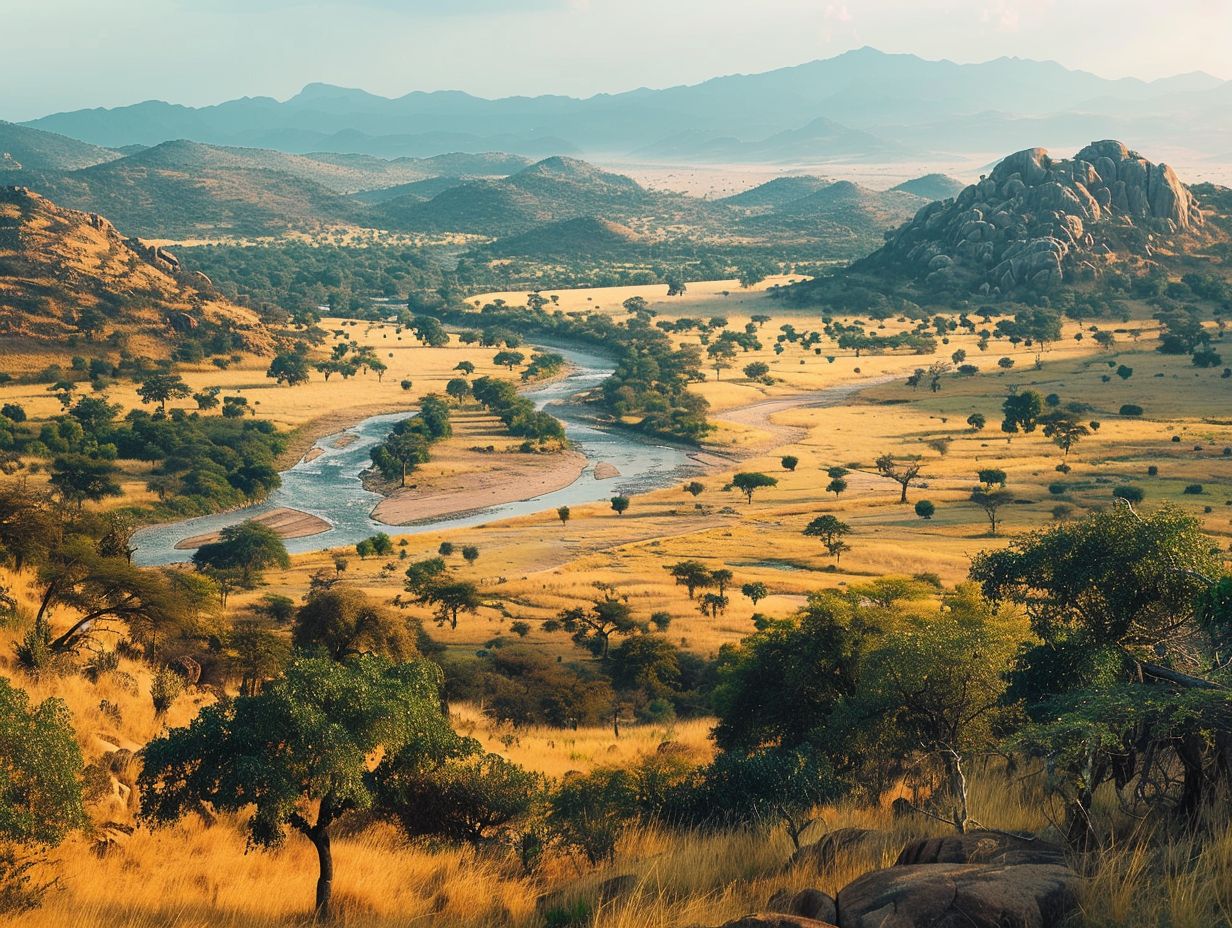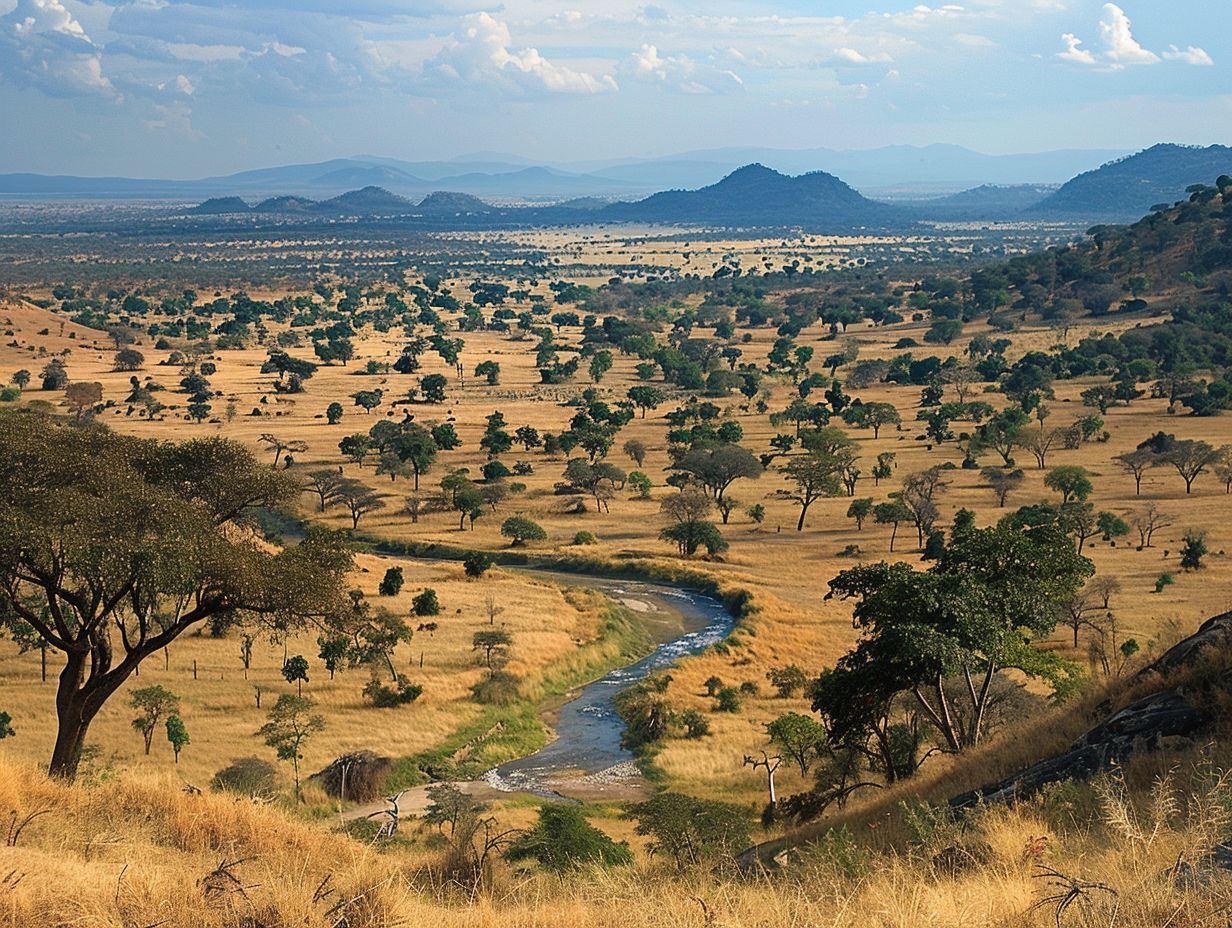
Ruaha National Park
Welcome to the ultimate guide to Ruaha National Park!
Located in Tanzania, this park is not only one of the largest in Africa but also one of the most diverse in terms of wildlife and landscapes.
We will explore the history of Ruaha National Park, its climate, the best time to visit, main attractions such as wildlife and bird watching, activities like game drives and walking safaris, accommodations available, and how to get there.
So, buckle up and get ready to embark on an adventure in this breathtaking wilderness!
Key Takeaways:

- Ruaha National Park is one of Tanzania’s largest and most biodiverse national parks, home to a wide variety of wildlife and landscapes.
- Located in the southern part of Tanzania, Ruaha National Park offers a unique and off-the-beaten-path safari experience.
- Visitors can explore the park’s rich history, diverse wildlife, and stunning landscapes through activities such as game drives, walking safaris, and cultural tours.
What is Ruaha National Park?
Ruaha National Park, located in Tanzania, is one of East Africa’s largest national parks known for its diverse wildlife, breathtaking landscapes, and conservation efforts.
It is home to a variety of wildlife species such as elephants, lions, and leopards, making it a popular destination for safari enthusiasts and nature lovers.
Stretching over 20,000 square kilometers, Ruaha National Park has a rich history steeped in conservation. Originally established in 1910 as a game reserve, it was later upgraded to a national park.
The park’s landscape is characterized by the Great Ruaha River, rolling hills, and acacia-dotted savannahs, creating a picturesque backdrop for the diverse wildlife that roams freely.
Where is Ruaha National Park located?
Ruaha National Park is situated in the southern part of Tanzania, within the Rungwa-Kizigo-Muhesi ecosystem, offering a unique wildlife experience in the heart of East Africa.
Nestled along the Great Rift Valley, Ruaha National Park spans over 20,226 square kilometers, making it the largest national park in Tanzania.
The park is bordered by the Great Ruaha River on one side, providing a lifeline for a diversity of wildlife, including elephants, lions, leopards, and over 570 bird species.
The landscape of Ruaha is characterized by rugged terrain, vast plains, and ancient baobab trees dotting the horizon, creating a picturesque backdrop for thrilling safaris and nature walks.
Accessibility to the park is facilitated through airstrips, and road networks connecting it to major cities like Iringa and Dodoma.
What is the History of Ruaha National Park?
Established in 1964, Ruaha National Park has a rich history of conservation efforts, particularly in collaboration with organizations like Asilia Africa and research initiatives.
Ruaha National Park, situated in Tanzania, was designated as a protected area to safeguard its diverse flora and fauna.
Over the years, it has emerged as a vital player in the conservation landscape, thanks to key partnerships with local communities, governmental bodies, and international NGOs.
Notably, Asilia Africa’s involvement has bolstered eco-tourism and sustainable practices within the park, contributing significantly to its preservation.
Research projects centered around the Usangu Wetlands have yielded valuable insights, guiding effective conservation strategies and enhancing biodiversity management.
What is the Climate of Ruaha National Park?
Ruaha National Park experiences a diverse climate due to its varied landscapes, ranging from the wetlands of Usangu to the arid Mdonya woodlands providing a unique ecosystem.
Within this vast wilderness, the park witnesses distinct seasonal variations, with the wet season lasting from November to April rejuvenating the vegetation and filling the rivers and watering holes.
In contrast, the dry season, from May to October, transforms the landscape into a parched savannah, making wildlife congregations around water sources a common sight.
These climatic changes not only impact the park’s vegetation but also influence the behavioral patterns of its inhabitants, such as elephants migrating in search of water during drier months.
What is the Best Time to Visit Ruaha National Park?
The best time to visit Ruaha National Park for optimal wildlife viewing and tourism experiences is during the dry season, from June to October, when the animals congregate around water sources.
During this period, providing visitors with unrivaled chances to spot a wide array of species, including elephants, lions, leopards, and buffalos in their natural habitat.
The dry season offers clear skies and cooler temperatures, making it more comfortable for exploring the park and undertaking activities like game drives, walking safaris, and birdwatching excursions.
The vegetation is less dense, enhancing visibility and ensuring memorable wildlife encounters.
What are the Main Attractions in Ruaha National Park?
Ruaha National Park boasts a myriad of attractions, from its majestic predators like lions, leopards, and cheetahs to the serene beauty of the Great Ruaha River, offering a unique ecosystem that can be explored through guided walking safaris amidst diverse bird species and stunning landscapes.
1. Wildlife

The wildlife in Ruaha National Park includes a diverse array of species such as elephants, giraffes, buffaloes, kudus, impalas, and various antelope species, along with iconic predators.
These animals thrive in different habitats within the park; elephants and buffaloes can be spotted near water sources, while giraffes gracefully roam the savannah plains.
Kudus and impalas are often found in wooded areas, utilizing their agility to navigate the dense vegetation.
The presence of lions, leopards, cheetahs, and spotted hyenas signifies a balanced predator-prey dynamic in the ecosystem, essential for maintaining a healthy population.
2. Bird Watching
Bird watching enthusiasts will be delighted by the diverse avian population in Ruaha National Park offering a paradise for ornithologists and nature lovers.
The park’s varied habitats, including miombo woodlands, open plains, and riverbanks, attract a wide array of bird species ranging from vibrant bee-eaters and rollers to majestic raptors.
Spring and autumn herald the seasonal migrations of species like cuckoos and European bee-eaters, adding a dynamic element to bird-watching pursuits in Ruaha.
Exploring the park’s diverse ecosystems presents opportunities to spot rare and endemic bird species such as Ruaha red-billed hornbills and yellow-collared lovebirds.
3. Scenery and Landscapes
The landscapes of Ruaha National Park are adorned with stunning vistas, including iconic baobab trees, lush vegetation, and diverse habitats
One of the most striking features of Ruaha National Park is the vast array of baobab trees that dot the landscape, their towering trunks and gnarled branches standing out against the blue skies.
These majestic trees, known as the ‘Tree of Life,’ add a sense of ancient wonder to the surroundings.
The park also boasts a variety of vegetation types, from open plains to rocky outcrops, providing a diverse and dynamic environment for both plant and animal life.
The geological formations within the park, such as the Great Ruaha River and the dramatic escarpments, further enhance the beauty of this natural wonderland.
4. Cultural Experiences
Beyond its natural wonders, Ruaha National Park offers enriching cultural experiences that highlight local traditions, conservation efforts, and community involvement.
One of the remarkable cultural initiatives in the park is the engagement with local communities to showcase their traditional dances, crafts, and storytelling sessions.
These interactions not only preserve the rich cultural fabric of the region but also offer a platform for visitors to immerse themselves in the authentic local way of life.
Various conservation projects within the park, such as anti-poaching initiatives and sustainable tourism practices, demonstrate the park’s commitment to protecting its biodiversity.
By promoting environmental awareness and involving locals in conservation efforts, Ruaha National Park stands as a beacon of sustainable development and cultural preservation in Tanzania.
What Activities Can Be Done in Ruaha National Park?
Ruaha National Park offers a plethora of exciting activities for visitors, including thrilling game drives to spot elephants and predators, immersive walking safaris through the wilderness, serene water safaris along the Great Ruaha River, and exploratory drives in specially equipped Land Rovers for a unique safari experience.
1. Game Drives
Embark on exhilarating game drives in Ruaha National Park to witness iconic wildlife like elephants, predators, and other native species.
As you traverse through the rugged landscapes of Ruaha National Park in search of wildlife treasures, you may encounter towering herds of elephants gracefully moving across the savannah.
The experienced guides navigating these expeditions provide fascinating insights into the animal behaviors and ecosystems, heightening the sense of adventure and discovery.
With the designated Land Rovers equipped with elevated viewing platforms and open sides, you are immersed in the sights and sounds of the wilderness.
Guided by expert rangers, each game drive ensures not only remarkable sightings but also follows strict safety protocols to uphold the harmony between humans and wildlife.
2. Walking Safaris
Immerse yourself in the wonders of nature with guided walking safaris in Ruaha National Park, where you can explore the wilderness, discover local flora and fauna, and support conservation.
Walking safaris in Ruaha National Park offer a unique opportunity to connect with the environment on a deeper level.
As you traverse the rugged terrain of this untamed wilderness, you will witness the intricate ecosystems that sustain a myriad of wildlife species.
Guided by experienced naturalists, you’ll learn about the delicate balance of nature and the importance of conserving these habitats for future generations.
These safaris provide a more intimate experience compared to traditional game drives, allowing you to absorb the sights, sounds, and scents of the African bush.
By treading lightly on the earth and minimizing your environmental impact, you contribute directly to the preservation of this precious ecosystem.
3. Bird Watching

Bird enthusiasts can indulge in exceptional bird-watching opportunities in Ruaha National Park, where a diverse array of avian species and habitats await.
Ruaha National Park boasts a remarkable list of bird species comprising over 570 different types, from majestic raptors soaring high above acacia trees to colorful sunbirds flitting.
Visitors can observe endemic species such as the Ruaha Red-billed Hornbill known for its distinctive call echoing through the savannah or the Golden-winged sunbird.
During the rainy season, numerous migratory birds flock to the park, enhancing the bird-watching experience with the sight of numerous waterfowl and other migratory species.
4. Cultural Tours
Embark on enriching cultural tours in Ruaha National Park to explore local traditions, community initiatives, and conservation projects, with highlights including visits to the Usangu Expedition Camp.
These cultural tours not only offer a glimpse into the rich history and traditions of the local communities but also provide insights into the sustainable practices employed in the park.
Travelers have the opportunity to engage with community members, learning about their daily life and unique customs.
Through these immersive experiences, visitors gain a deeper appreciation for the interconnectedness of conservation efforts and community well-being.
What Accommodations are Available in Ruaha National Park?
Ruaha National Park provides a range of accommodations to suit every traveler’s preference, from luxurious lodges and comfortable tented camps to rustic camping sites and unique stays at the Usangu Expedition Camp, ensuring a memorable safari experience for all visitors.
1. Lodges
Experience luxury and comfort amidst the wilderness by staying in the lodges of Ruaha National Park, offering premium amenities, stunning views, and a close connection to nature.
Ruaha National Park boasts a range of exquisitely crafted lodges that cater to discerning travelers seeking a lavish experience in the heart of the African bush.
The accommodations blend seamlessly with the surrounding landscape, offering a harmonious atmosphere for guests to relax and unwind.
From opulent suites with private decks overlooking the plains to cozy cottages nestled under the sprawling acacia trees, each lodge in the park exudes its own charm and character.
The lodges are strategically located near watering holes and game trails, allowing visitors to witness the vibrant wildlife up close, creating unforgettable moments during their stay.
2. Tented Camps
Immerse yourself in the beauty of Ruaha National Park with a stay at the tented camps, where you can enjoy an authentic bush, support conservation efforts, and witness the wonders of the wilderness.
The tented camp accommodations in Ruaha National Park offer a unique blend of sustainability and comfort. Built with eco-friendly materials and practices in mind.
Surrounded by the sights and sounds of the wild, guests have the opportunity to connect with nature on a profound level, gaining a deeper appreciation for the delicate balance of the ecosystem.
These camps are not just places to rest; they are hubs of conservation where visitors can learn about local wildlife and contribute to ongoing research and protection efforts.
3. Camping Sites
For an outdoor adventure under the starlit skies, camping sites offer a rustic yet rewarding experience, allowing guests to immerse themselves in nature, contribute to biodiversity conservation, and enjoy the pristine wilderness.
Whether you prefer traditional tent camping or the comfort of permanent tented camps, Ruaha National Park has diverse camping options to suit every traveler’s taste.
Imagine waking up to the symphony of birdsong, sounds of the wild, and the stunning sunrise breaking over the horizon. Each campsite is strategically located to provide a sense of serenity.
With eco-friendly practices at the core, camping here not only connects you with nature but also ensures minimal impact on the environment.
How to Get to Ruaha National Park?
Accessing Ruaha National Park is convenient, with options including internal flights to airstrips near the park, road transfers from major cities like Dar es Salaam, and international connections via airlines such as Emirates and Kenya Airways operating from the Julius Nyerere International Airport.
1. By Air

Traveling to Ruaha National Park by air offers a quick and scenic option, with internal flights connecting to nearby airstrips for easy access to the park.
While helicopter transfers provide a luxurious and efficient mode of transportation for visitors seeking a unique safari experience.
Internal flights to Ruaha National Park offer stunning aerial views of the surrounding landscapes, allowing guests to start their adventure as soon as they board the plane.
With several reputable aviation services operating regular flights to the park, travelers have a variety of scheduling options to choose from, making it easier to plan their journey.
The availability of helicopter transfers adds a touch of exclusivity and comfort to the travel experience, perfect for those looking to make their safari getaway even more special.
2. By Road
Journeying to Ruaha National Park by road offers a scenic route from cities like Dar es Salaam, allowing travelers to witness the beauty of the Tanzanian landscapes.
As you embark on this road adventure, the journey takes you through the heart of Tanzania, offering a glimpse into local life and culture along the way.
The well-maintained road networks provide a comfortable ride, with opportunities to spot majestic baobab trees and stunning vistas of the Great Rift Valley.
Upon approaching Ruaha National Park, keep your eyes peeled for sightings of elephants, lions, and giraffes roaming freely in their natural habitat.
The anticipation builds with each passing mile, leading to an unforgettable safari experience once you enter the park gates.
Frequently Asked Questions
1. Where is Ruaha National Park located?
A: Ruaha National Park is located in the southern part of Tanzania, in East Africa.
2. What is the size of Ruaha National Park?
A: Ruaha National Park covers an area of approximately 20,226 square kilometers, making it the largest national park in Tanzania.
3. What is the best time to visit Ruaha National Park?
A: The best time to visit Ruaha National Park is during the dry season, from June to October, when the animals gather around water sources and are easier to spot.
4. What kinds of animals can be found in Ruaha National Park?
A: Ruaha National Park is home to a wide variety of animals, including elephants, lions, leopards, cheetahs, giraffes, zebras, hippos, and over 400 species of birds.
5. Can visitors go on a safari in Ruaha National Park?
A: Yes, visitors can go on a safari in Ruaha National Park, either by vehicle or on foot with a trained guide. Walking safaris offer a unique and exciting way to experience the park’s diverse wildlife and landscapes.
6. Is it safe to visit Ruaha National Park?
A: Yes, it is generally safe to visit Ruaha National Park. However, visitors should always follow the safety guidelines provided by the park and be aware of potential risks, such as wild animals and extreme weather conditions.